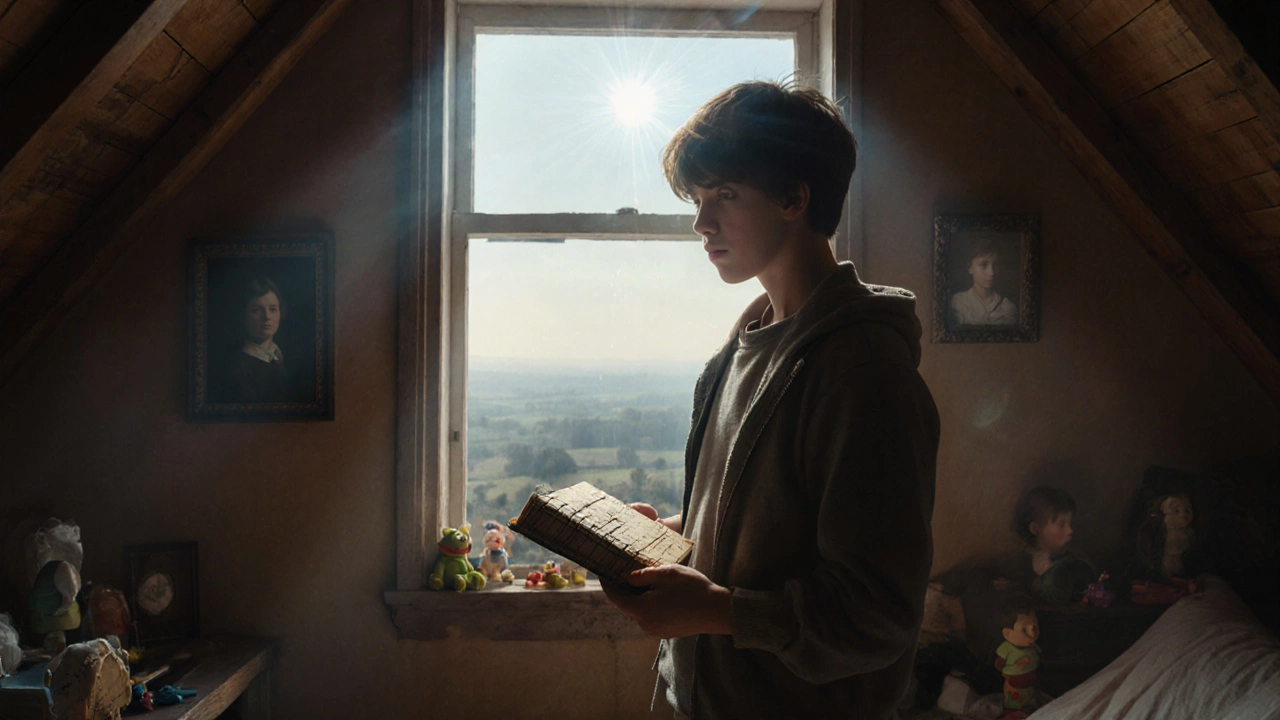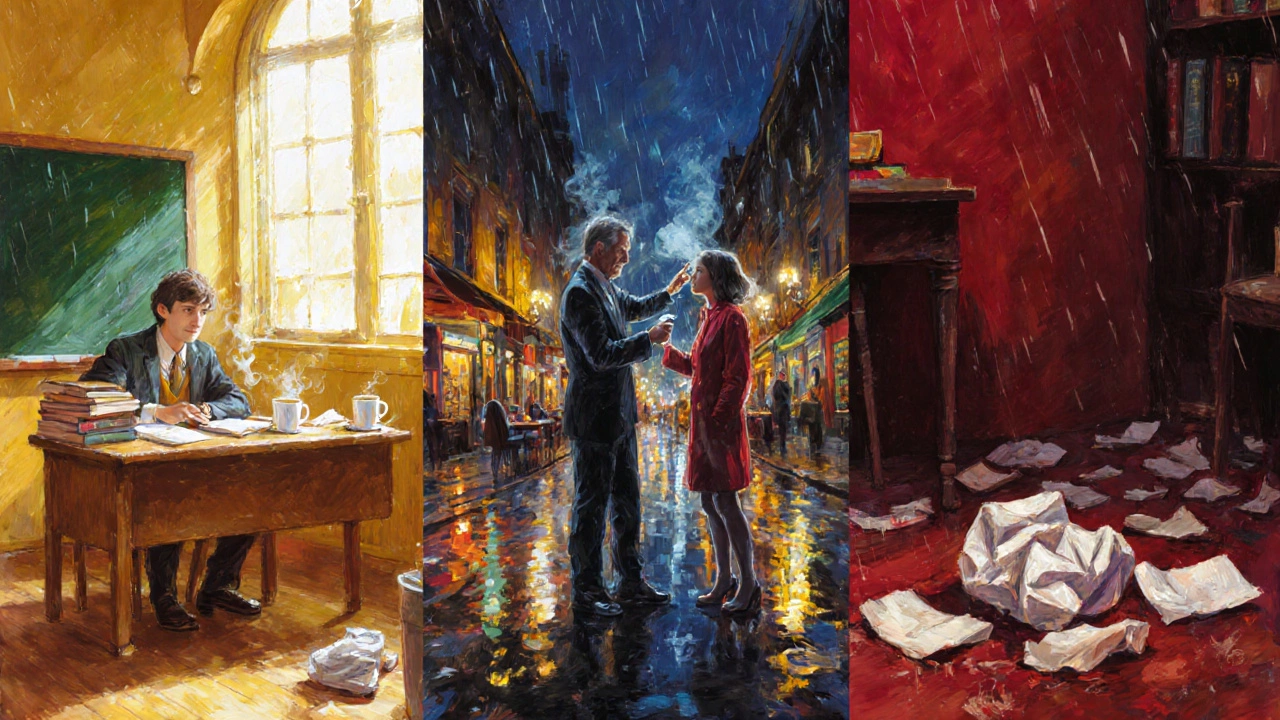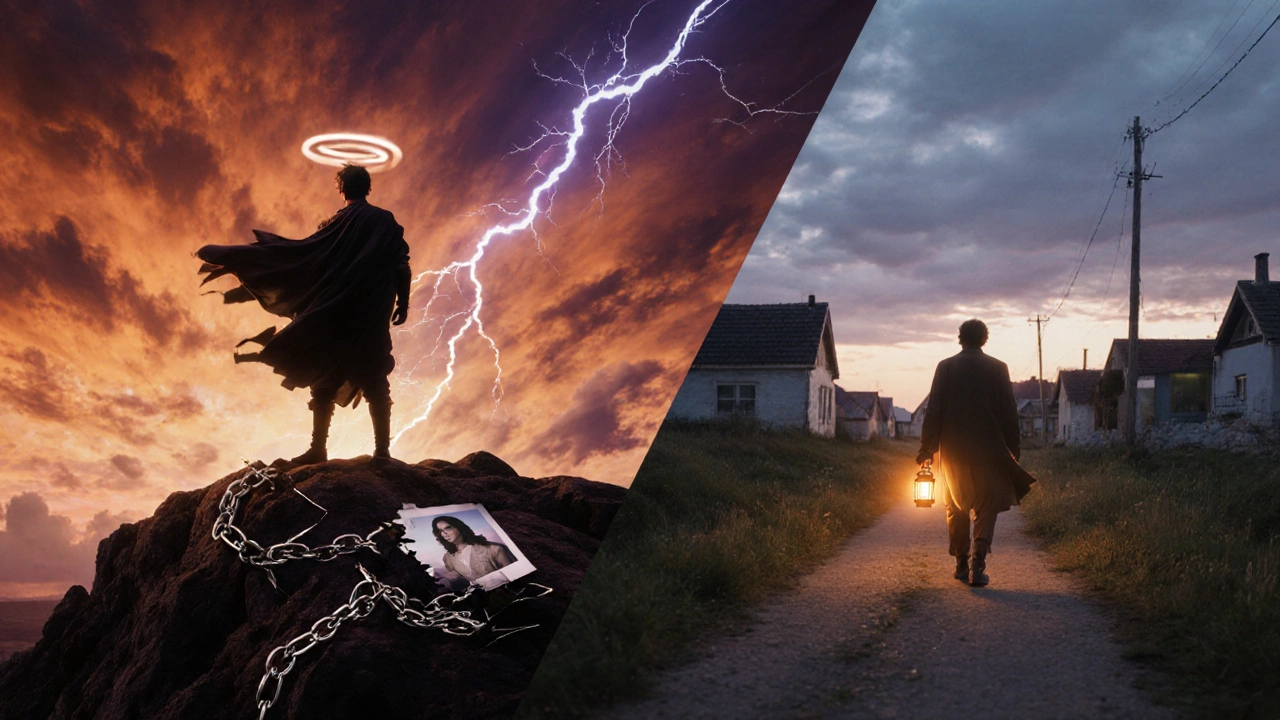Four Stages of a Bildungsroman: A Clear Guide
 Oct, 8 2025
Oct, 8 2025
Bildungsroman Stage Checker
Analysis Results
Four Stages of a Bildungsroman
Call to Adventure
The protagonist feels dissatisfied with their current life and is pushed toward change by a catalyst event.
Example: Jane Eyre's miserable childhood at Gateshead prompts her desire for freedom.
Road of Trials
The protagonist faces various challenges that test their values and skills.
Example: Pip's apprenticeship with Joe and exposure to Satis House shape his worldview.
Crisis & Transformation
A pivotal moment forces the protagonist to reassess their identity and beliefs.
Example: Wilhelm's disillusionment with the artistic salon world leads to self-discovery.
Return with New Insight
The protagonist returns with newfound understanding and wisdom.
Example: Holden Caulfield's final ride hints at acceptance of adult responsibilities.
Checklist for Identifying Stages
- Stage 1: Look for a clear inciting incident that makes the youth uncomfortable.
- Stage 2: Map out at least three distinct trials—school, work, relationships.
- Stage 3: Identify a turning point where the protagonist must choose or loses something essential.
- Stage 4: Notice how the ending reflects a changed self, whether it’s a return home or a forward leap.
- Check for internal moral development beyond love or romance.
- Look for nuanced resolution, not just romance or triumph.
Ever wondered why some novels feel like a personal road trip for the hero? The secret lies in the Bildungsroman is a a literary genre that charts a character’s moral and psychological growth from youth to adulthood. Understanding its four classic stages helps you spot the pattern in classics, pick the next great read, or even map your own life story onto fiction.
Quick Takeaways
- The Bildungsroman follows four distinct stages: Call to Adventure, Road of Trials, Crisis & Transformation, and Return with New Insight.
- Each stage aligns with typical plot points in a coming‑of‑age novel, making the structure easy to recognize.
- Key elements-protagonist, conflict, theme, and resolution-shift focus as the character matures.
- Classic examples like Goethe’s WilhelmMeistersLernjahre and Salinger’s Catcher in the Rye illustrate all four phases.
- Use the stage checklist to analyze any novel’s growth arc or to craft your own coming‑of‑age story.
What Is a Bildungsroman?
In simplest terms, a Bildungsroman is a novel that follows a young protagonist’s journey toward self‑realization. The term, coined in 19th‑century Germany, combines “Bildung” (formation or education) with “Roman” (novel). It isn’t just any story about youth; it deliberately tracks inner change, societal integration, and the quest for identity.
Stage1: The Call to Adventure
Every Bildungsroman opens with a restless youth confronting the limits of their current world. This is the bildungsroman stages starting point: a yearning for something beyond home, school, or family. The protagonist-often an adolescent who feels out of place-experiences a catalyst, like a death, a move, or an unexpected encounter. The narrative stakes are set, and the reader senses the tension between innocence and the unknown.
Key markers:
- Clear dissatisfaction or sense of incompleteness.
- A trigger event that pushes the character out of routine.
- Introduction of the central conflict (internal and external) that will drive the plot.
Example: In Jane Eyre, the titular orphan’s misery at Gateshead sparks her desire for freedom and belonging.

Stage2: The Road of Trials
Once the hero steps onto the path, a series of challenges tests their values and skills. This middle section mirrors the classic “coming of age” arc where the protagonist meets mentors, faces setbacks, and experiments with new identities. The narrative often expands to secondary characters-friends, rivals, love interests-who reflect alternative life choices.
During this phase, the theme of growth is reinforced through concrete experiences:
- Education or apprenticeship that introduces new knowledge.
- Romantic or social entanglements that reveal emotional blind spots.
- Failures that force the protagonist to reassess goals.
Classic illustration: In Great Expectations, Pip’s apprenticeship with Joe, his exposure to Satis House, and his obsession with Estella create a cascade of trials that shape his worldview.
Stage3: Crisis & Transformation
At the story’s midpoint, the protagonist confronts a crisis that forces a decisive shift. This is the emotional climax where the character’s old self can no longer survive. Often the crisis is a moral dilemma-choosing between personal desire and societal duty-or a moment of profound loss.
Transformation occurs in two layers:
- Psychological: the hero gains self‑awareness, recognizing flaws and strengths.
- Social: the character redefines relationships with family, community, or the broader world.
In Goethe’s WilhelmMeistersLernjahre, Wilhelm’s disillusionment with the artistic salon world triggers his turn toward authentic self‑discovery.
Stage4: Return with New Insight
The final stage wraps up the growth arc. The protagonist either returns to their origin with new wisdom or moves forward into a re‑imagined future. This “return” isn’t a simple undoing; it’s a reintegration where the character applies learned lessons to real life.
Typical hallmarks:
- Resolution of the central conflict, often through acceptance rather than triumph.
- Explicit articulation of the lesson-either spoken or implied.
- Establishment of a stable adult identity, even if the ending is ambiguous.
Consider Holden Caulfield in Catcher in the Rye. He never fully settles, but his final ride home hints at a begrudging acceptance of adult responsibilities.

How to Spot the Four Stages in Any Novel
When you read, keep an eye on these checkpoints:
- Stage 1: Look for a clear inciting incident that makes the youth uncomfortable.
- Stage 2: Map out at least three distinct trials-school, work, relationships.
- Stage 3: Identify a turning point where the protagonist must choose or loses something essential.
- Stage 4: Notice how the ending reflects a changed self, whether it’s a return home or a forward leap.
Using this checklist, you can quickly label a novel as a Bildungsroman, even if the author never uses the term.
Common Pitfalls and How to Avoid Them
Writers and readers sometimes confuse the structure with generic “growth stories.” Here are mistakes to watch for:
| Misinterpretation | Why It’s Wrong | Correct Lens |
|---|---|---|
| Assuming any romance equals a Bildungsroman | Romance may lack the protagonist’s self‑education arc. | Check for internal moral development beyond love. |
| Passing over the crisis as a minor setback | The crisis drives transformation; if it’s trivial, the story likely isn’t a true Bildungsroman. | Identify a moment that forces a reevaluation of identity. |
| Ending with a tidy happy‑ever‑after | Many Bildungsromans end ambiguously or with bittersweet acceptance. | Look for nuanced resolution, not just romance or triumph. |
By staying alert to these cues, you’ll avoid over‑labeling and appreciate the genre’s subtlety.
Practical Tips for Writers
If you’re crafting your own coming‑of‑age story, follow these pro tricks:
- Start with a vivid “call” that feels personal-maybe a family secret or a sudden move.
- Design at least three trials that test different aspects: intellect, heart, and morality.
- Make the crisis emotionally unavoidable; the protagonist should feel forced, not optional.
- End with a concrete sign of growth: a new job, a written letter, or an altered worldview.
Remember, the goal isn’t just plot; it’s to map an internal map that readers can see themselves in.
Frequently Asked Questions
What defines a Bildungsroman compared to a regular novel?
A Bildungsroman specifically tracks a young protagonist’s moral, psychological, and social development, usually across four recognizable stages. A regular novel may focus on plot, external conflict, or adult characters without that growth arc.
Are there modern examples of the four‑stage structure?
Yes. John Green’s Looking for Alaska, Stephen Chbosky’s The Perks of Being a Wallflower, and Celeste Ng’s Everything I Never Told You all follow the call, trials, crisis, and return pattern, though some end on a bittersweet note.
Can a story have more than four stages?
The classic model lists four, but many authors expand with sub‑stages-like a “mentor phase” within the Road of Trials. The core idea remains: a clear call, a series of challenges, a transformative crisis, and a concluding insight.
How do I use the four stages to analyze a novel for a literature essay?
Identify the inciting incident, list at least three trials, pinpoint the protagonist’s crisis, and explain how the ending shows growth. Cite textual evidence for each stage and discuss how the author’s language reinforces the transformation.
Is a Bildungsroman always set in the past?
No. While early examples like Goethe’s work are historical, contemporary settings-high school, college, or even virtual worlds-fit the genre as long as the growth arc is present.